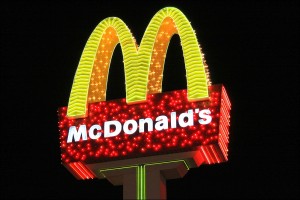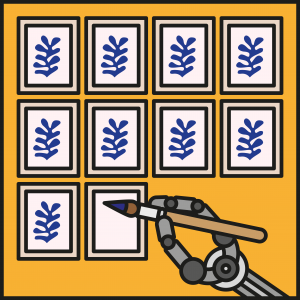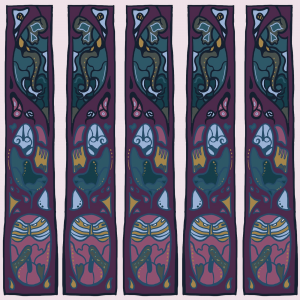Going the Whole Hog: Rembrandt and the Art of Butchery
by Emily Bauer | February 11, 2024
Below, there hang four flayed brutes. Some taut as if the paint was pulled thin like latex, others like heaps of wax. Each brings to mind the feverish glow of something coldly sweating, all seem to hug the gloam. Attributed to either Rembrandt or a nondescript ‘follower of Rembrandt’, the mass represented has been named ‘Slaughtered Ox’. You’ll find ‘Slaughtered Pig’, ridded of that ill gleam, Fabritius, Beuckelaer and Netscher deliver us to pinker, snouted pastures. Ox is to beef as pig is to pork: this is a trail of carcass imitation, a chain of finely executed lessons in the labour of hands, and the anatomy of something nearly meat. Yet in wider terms, it is a display of fatty art, that plates up death without condiments, and where our seat at the table is a position of both fast and feast.
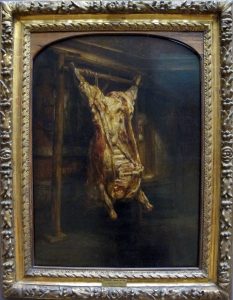
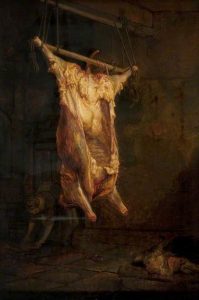
These particular paintings hang in Paris, Budapest, Glasgow and Philadelphia, yet the image of a dead pig or ox is scattered wide. From Aertsen to Bacon to Soutine, butchery trots around the marketplace, perched above terracotta tiles and at the foot of each rolled up sleeve, it is as constant as baked bread. Even the canvas becomes its own hanging swine. Stretched out between wood, strung up and gobbled down in a glance, it is a sight of potential creative sustenance – as off-white as flayed flesh, it was indeed with his ox that Rembrandt fed the brushes of his disciples. Yet this is a fashion that goes back further than the seventeenth century. In medieval times, depictions of slaughtered pigs and oxen were a means of honouring the labour that fed and bled these beasts into consumables. In the Dutch genre, the stretched-out body of a swine or cow became a vanitas allegory, a reminder that one day we too will be as stolid as a dead pig.
Often pictured alongside the hanging carcass of a swine was a ruddy faced child or two blowing up the pig’s bladder for a ball. In one particular Dutch print book such an image was accompanied with a line of verse; “How hard you blow, o child of the world! You catch nothing but wind. The world is nothing more than a bladder filled with air”. From a lively memorial of life to a jollily morbid awareness of its fragility, the splayed beast harkens back as well as it signals forth, back to the noble and bucolic, forth towards all our fleshy demises, and forth too, towards the fork. It is a duality I know well.
When, as a ruddy faced child myself, my father called for me to come and see a friend’s pig in the back of a transit van outside our house, I detected not his tone of glee. Over I tore with thoughts of something warm and grunting in straw. Promptly, I was met with half a dead pig, nestled among a boot load of pork chops, loins and back bacon. However, this fable was not merely a lesson in the diversity of pork products, but a teaching in the pink and white horrors of meat. A bloodless meat; rosy and sculpted like modelling clay. It seemed to have been slaughtered in the instant between my imagining a live pig and my seeing of a dead one.
In verse, Ted Hughes joins the parade of artistic butchers and paints the ‘thick pink bulk’ of a dead pig– it is on the cusp of this same instant of ‘becoming’, as men gather to ‘scald and scour it like a doorstep’. Just like a doorstep, the corpse is a threshold of field and fork. The weight of its body is not far from a violent honouring of its life:
“Pigs must have hot blood, they feel like ovens.
Their bite is worse than a horse’s—
They chop a half-moon clean out.
They eat cinders, dead cats.”
Brought to mind is the purple crescent sneer welded into my sister’s arm, the artist being the clamped jaw of a yellow haired sow next door. This sow was a big girl named Frazzle, the same pig who, from the bathroom window, I watched flip a runt lamb onto her snout and send it somersaulting across the paddock like a lavender bag. She barked like a dog and screamed like a woman. It seems improbable that any hand could scald or flay Frazzle, without themselves being flayed. She reminds us of the clamour and the struggle behind the painting, the cloven kicks and crescent bites. The animal is vicious, and so its taming is a sombre one. We may however ask what these things are doing dead in paint, or poem or image. Should they not belong to the archive of some abattoir, like mug shots in a ring binder? Or at least among the turf of a butcher’s counter. The importance however, an importance wildly pressing in the days of 26 story pig farm skyscrapers, lies in the wholeness of the individual form, and as a result, its otherness. Not often are we able to perceive of the animal in this liminal state; after paddock, before plate. It is between identities, with no head to really tell us who it was and no fork-worthy shape to indicate what it may be – it is, in Hughes’ words, ‘less than lifeless’. So how do we reckon with such a thing that doesn’t yet fit into our mouths? Rembrandt’s answer, an answer historically arrived at, was to paint it, and in doing so, prevent it from moving along in the process of consumption, rendering it a sculpture of our own human and inhuman tendency.
Playing with our food is impolite, and here it is bathed in oil paint and turpentine, to be eternally hung, forever uneaten. It is an omen of remembrance; remembering the furrowing, fighting and flaying, the blood, nose and tail – all the parts that don’t make it out of paint.∎
Words by Emily Bauer.

